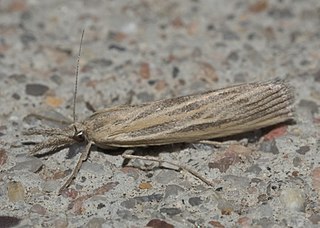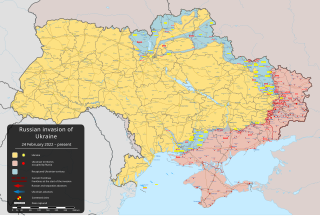
The Islamic State, at times known as the Islamic State of Iraq and the Levant or the Islamic State of Iraq and Syria and also referred to by its Arabic-language acronym Daesh, is an Islamist militant jihadist group and former unrecognized quasi-state that follows a Salafi jihadist doctrine based on the Sunni branch of Islam. It was founded by Abu Musab al-Zarqawi in 1999 and gained global prominence in 2014, when it drove Iraqi security forces out of key cities during the Anbar campaign, which was followed by its capture of Mosul and the Sinjar massacre.

Crambinae is a large subfamily of the lepidopteran family Crambidae, the crambid snout moths. It currently includes over 1,800 species worldwide. The larvae are root feeders or stem borers, mostly on grasses. A few species are pests of sod grasses, maize, sugar cane, rice, and other Poaceae. The monophyly of this group is supported by the structure of the tympanal organs and the phallus attached medially to the juxta, as well as genetic analyses.

Thaumatopsis is a genus of moths of the family Crambidae.

Teretiopsis thaumastopsis is a species of sea snail, a marine gastropod mollusk in the family Raphitomidae.

The Russo-Ukrainian War is an ongoing war between Russia and Ukraine. It began in February 2014 following the Ukrainian Revolution of Dignity, and initially focused on the status of Crimea and parts of the Donbas, internationally recognised as part of Ukraine. The first eight years of the conflict included the Russian annexation of Crimea (2014) and the war in Donbas (2014–present) between Ukraine and Russian-backed separatists, as well as naval incidents, cyberwarfare, and political tensions. Following a Russian military build-up on the Russia–Ukraine border from late 2021, the conflict expanded significantly when Russia launched a full-scale invasion of Ukraine on 24 February 2022.
Thaumatopsis actuellus is a moth in the family Crambidae. It was described by William Barnes and James Halliday McDunnough in 1918. It is found in North America, where it has been recorded from Florida and Texas.
Thaumatopsis atomosella is a moth in the family Crambidae. It was described by William D. Kearfott in 1908. It is found in the US states of Arizona and California.
Thaumatopsis bolterellus is a moth in the family Crambidae. It was described by Charles H. Fernald in 1887. It is found in North America, where it has been recorded from New Mexico and Texas.
Thaumatopsis crenulatella is a moth in the family Crambidae. It was described by William D. Kearfott in 1908. It is found in the US states of Arizona, California, Colorado and Nevada.
Thaumatopsis edonis is a moth in the family Crambidae. It was described by Augustus Radcliffe Grote in 1880. It is found in North America, where it has been recorded from Florida, Kentucky, Maine, Massachusetts, Mississippi, Missouri, Nebraska, New Jersey, Oklahoma and South Carolina. It is listed as threatened in the US state of Connecticut.
Thaumatopsis fernaldella is a moth in the family Crambidae. It was described by William D. Kearfott in 1905. It is found in North America, where it has been recorded from Alberta, California, Florida, Maryland, Mississippi, Nevada, New Mexico, Oklahoma, Saskatchewan and Texas. The habitat consists of prairies.
Thaumatopsis fieldella is a moth in the family Crambidae. It was described by William Barnes and James Halliday McDunnough in 1912. It is found in North America, where it has been recorded from California.
Thaumatopsis floridella, the Floridian grass-veneer, is a moth in the family Crambidae. It was described by William Barnes and James Halliday McDunnough in 1913. It is found in North America, where it has been recorded from coastal areas in Florida, Georgia, Mississippi, South Carolina and North Carolina, New Jersey, New York, and Rhode Island. It is also found in Cuba.
Thaumatopsis magnificus is a moth in the family Crambidae. It was described by Charles H. Fernald in 1891. It is found in North America, where it has been recorded from New Mexico, Arizona and Colorado.
Thaumatopsis melchiellus is a moth in the family Crambidae. It was described by Herbert Druce in 1896. It is found in Guerrero, Mexico.
Thaumatopsis pectinifer is a moth in the family Crambidae. It was described by Zeller in 1877. It is found in North America, where it has been recorded from North Dakota to Oklahoma, Texas and southern Florida, as well as Michigan and Indiana.

Thaumatopsis pexellus, the woolly grass-veneer, is a moth in the family Crambidae. It was described by Philipp Christoph Zeller in 1863. It is found in most of North America. The habitat consists of grasslands.
Thaumatopsis repandus is a moth in the family Crambidae. It was described by Augustus Radcliffe Grote in 1880. It is found in North America, where it has been recorded from Arizona, British Columbia, California, Colorado, New Mexico, Oregon and Washington.
Thaumatopsis solutellus is a moth in the family Crambidae. It was described by Zeller in 1863. It is found in North America, where it has been recorded from Indiana, Maryland, Massachusetts, New Hampshire, New Jersey and Ontario.




